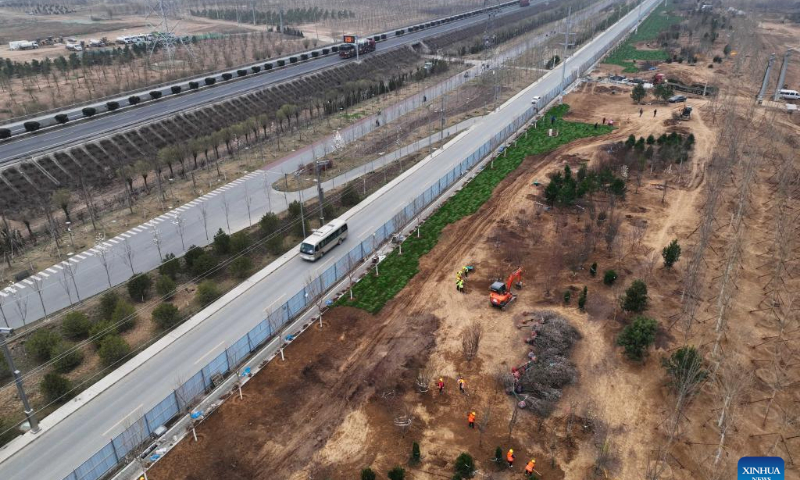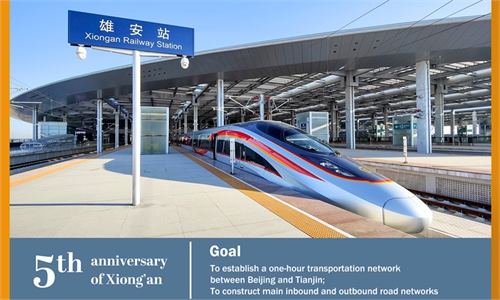'Blockchain embedded in DNA' – Xiong'an shows how the future will be like as it hosts hundreds of tech trials
'City of future' brings futuristic digital urban living to life

Aerial photo taken on March 29, 2022 shows the construction site of Minglangnan Street in Xiong'an New Area, north China's Hebei Province. The upgrading construction of Minglangnan Street is scheduled to complete in September. Photo: Xinhua
From digital currency and blockchain, to autonomous driving - many of these tech buzzwords remain "words" in most places around the globe, but in Xiong'an New Area, China's "city of the future" under construction they have become ubiquitous in the daily lives of residents.
As Xiong'an marks the fifth anniversary of the establishment of the new area, it has already become a test ground for all the country's and indeed the world's most advanced technologies, in line with the top design for the city to become a demonstration model in innovation.
The newest business adoption of the digital yuan came as the local branch of Bank of China cooperated with BOC Fullerton Community Bank to jointly promote the application scenarios of digital yuan in non-operating institutionswith the new cooperation model between banks, the official website of the Xiong'an New Area reported.
The new cooperation model between banks will provide non-operating institutions with functions such as opening digital wallets, connecting with cards, and a variety of functions.
Multiple application scenarios for digital yuan have been tested in Xiong'an New Area since 2020, which have played an important role in bringing more convenience to local residents' daily payments, and some infrastructure facilities are still under construction, Wang Peng, an assistant professor at the Gaoling School of Artificial Intelligence at the Renmin University of China, told the Global Times on Thursday.
Wang noted that the combination of digital yuan and blockchain technology has efficiently assisted the issuance of salaries to workers who participated in the construction of the Xiong'an New Area.
"Blockchain technology was embedded in the DNA of the Xiong'an New Area from the beginning," Xie Bingxin, vice secretary of Xiong'an Intelligent City Innovation Federation, told the Global Times on Thursday, noting that the variety of blockchain application scenarios in the city is leading the entire country.
Xiong'an New Area has built an autonomous and controllable blockchain underlying platform with a layered multi-chain overall architecture, while the major features include cross-chain transactions, data sharing, and business collaboration, according to Xiong'an Blockchain Lab's official website.
A total of 25 application scenarios, targeting urban management, digital finance, industrial ecology, e-trade, base system and public service delivery, have already been widely applied in the daily operation of Xiong'an New Area.
A construction fund management blockchain system has been designed to realize the traceability and efficiency of the financial funds arrangement, which has accelerated the fund issuance process for each party involved in the projects, and lowered the possibility of enterprises defaulting on payments or delaying wages for migrant workers, said Xie.
Xie noted that the system has issued more than 1.4 billion yuan ($220 million) in wages to around 182,000 workers as of the end of 2021.
Meanwhile, a government investment project approval blockchain system has reformed the approval system of engineering construction projects, which has assisted in approving more than 400 billion yuan worth of projects and compressed the approval time by 60 percent, Xie said.
The construction of digital transportation is also an indispensable part of building the local digital infrastructure.
Several projects targeting digitalized roads have already been put in use, which integrated the digital information of the roads with facilities on the sides such as traffic lights, visual radar, and videos to better assist vehicles properly operate when using local roads.
As for trials for autonomous driving, Xie said the trials are proceeding smoothly and will be expanded following the continuous development of intelligent transportation and digital infrastructure, adding that the collaborative testing with technology enterprises is ongoing.
Moving forward, both Xie and Wang expect the construction process of the Xiong'an New Area to be a model in various fields for China's digital construction.
Xiong'an New Area is the first city that has a dedicated plan for constructing a smart city in the country's urban planning system, including a variety of implementation plans for projects in different sectors, as Xiong'an was built from a "blank piece of paper" based on specific standards for implementation, said Xie.
Xie noted that the standardized plan system for constructing the smart city in Xiong'an New Area includes three categories covering 12 directions with more than 200 standards. These standards can serve as a reference for the construction of other cities in China.

